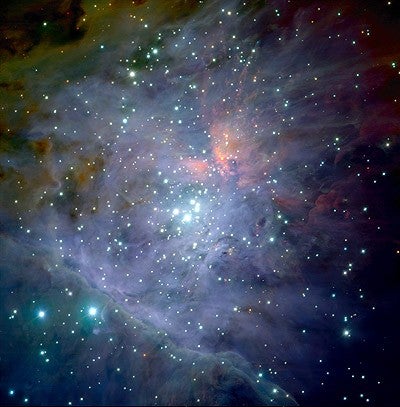

We don’t know for sure, but some of the massive stars in this nebula could be electroweak stars.
ESO/Mark McCaughrean
December 15, 2009
For some stellar objects, the final phase before or instead of collapsing into a black hole may be what a group of physicists is calling an electroweak star.
Glenn Starkman, a professor of physics at Case Western Reserve University, in Cleveland, Ohio, together with De-Chang Dai and Dejan Stojkovic, at the State University of New York in Buffalo, and Arthur Lue, at MIT’s Lincoln Lab, offer a description of the structure of an electroweak star in a paper submitted to Physical Review Letters.
Ordinary stars are powered by the fusion of light nuclei into heavier ones, such as hydrogen into helium in the center of our Sun. Electroweak stars, they theorize, would be powered by the total conversion of quarks — the particles that make up the proton and neutron building blocks of those nuclei — into much lighter particles called leptons. These leptons include electrons, but especially elusive, and nearly massless, neutrinos.
“This is a process predicted by the well-tested Standard Model of particle physics,” Starkman said. At ordinary temperatures it is so incredibly rare that it probably hasn’t happened within the visible universe anytime in the last 10 billion years, except perhaps in the core of these electroweak stars, he said.
In their dying days, stars smaller than 2.1 times our Sun’s mass die and collapse into neutron stars — objects dense enough that the neutrons and protons push against each other. More massive stars are thought to head toward collapse into a black hole. But at the extreme temperatures and densities that might be reached when a star begins to collapse into a black hole, electroweak conversion of quarks into leptons should proceed at a rapid rate, the scientists said.
The energy generated could halt the collapse, much as the energy generated by nuclear fusion prevents ordinary stars like the Sun from collapsing. In other words, an electroweak star is the possible next step before total collapse into a black hole. If the electroweak burning is efficient, it could consume enough mass to prevent what’s left from ever becoming a black hole.
Most of the energy eventually emitted from electroweak stars is in the form of neutrinos, which are hard to detect. A small fraction comes out as light, and this is where the electroweak star’s signature will likely be found, Starkman, said. But, “To understand that small fraction, we have to understand the star better than we do.” And until we do, it’s hard to know how to tell electroweak stars from other stars.
There’s time, however, to learn. The theorists have calculated that this phase of a star’s life can last more than 10 million years — a long time for us, though just an instant in the life of a star.
MORE NEWS TO CHECK OUT
New discoveries suggest low-mass planets are common around nearby stars
WISE spacecraft launches into orbit
Pioneering new survey telescope starts work









